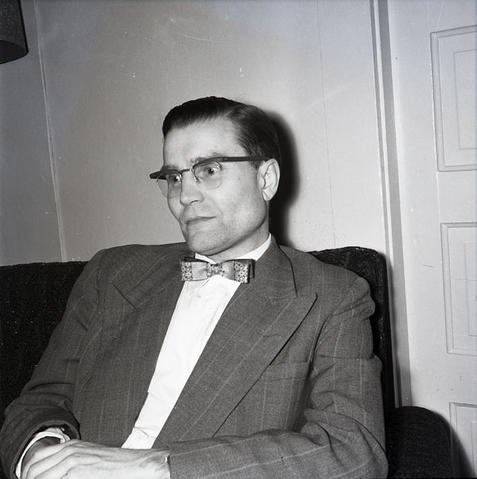Long before COVID-19 upended much of daily life in Squamish, another virus was taking lives and impacting local families.
A number of people in town still remember the days of polio, which, like COVID-19, reached its peak before the vaccine was to become widely distributed.
For local Judith Vetsch, polio is more than a thing that happened long ago and to someone else.
On Christmas Day, 1954, her father was rushed to the hospital, and eventually diagnosed with bulbar polio, one of the three types of the disease.
Vetsch's father developed profound paralysis and spent the next two months of his life in an iron lung, she recalled.
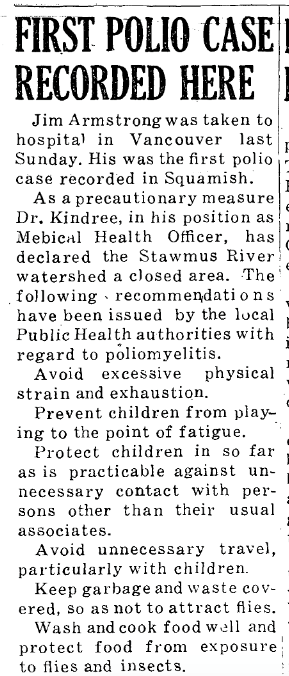
"The iron lung was an elongated tube, which had the apparatus to breathe for my father, as he lay there, helpless in every way," Vetsch recalled in an email to The Chief. She was able to visit him once, for her sister's birthday.
"Of course, the sight of my father in what looked like a torture chamber was something that will always stay with me," she said.
After the iron lung, her father had to use a chest respirator for several months to help him breathe. Eventually, he had to learn to walk again.
He re-trained with a course at a business college and worked in the office of a school supply business.
"Even here, though, he mostly used a wheelchair, and had to have a special desk to accommodate the wheelchair," Vetsch recalled.
It seemed that he was gradually getting back to a self-directing life.
But, then, one night in August 1957, her father "slipped away in his sleep."
He was 36 years old.
"He left my mother a widow, with six children under the age of 13.
"This was devastating to our family, of course. Many people helped us — family, neighbours, folks from church."
Vetsch said she has wondered about her father's experience. Why was he the only one in the family and why was he hit so hard, for example.
"I have been surprised to read that most people who have polio do not have severe symptoms," she said. "We see now with the COVID virus that it also affects people in many different ways."
She is not certain she received the Salk polio vaccine, which came out in 1955.
"I do not remember this, but my sister, Jane, says we received a few droplets of something on a sugar cube."
In the Shaw TV video Local History: Fern Green (part of the 2006 Not Just for Seniors series found at the Squamish Public Library), the late Fern Green talks about how her husband Kelly was hit hard by polio, in 1952, a time when the disease was at its peak in B.C.
He lived the rest of his life at the George Pearson Centre in Vancouver.
"Polio came around just before they had shots for [it]," said Green in the video. "There was a lot of polio, all over."
"Kelly got it quite bad," she said, adding a few other people she knew in town got the disease as well.
"Poor Dr. Kindree was the only game in town," she said. "He worked really hard. He made house calls night and day."
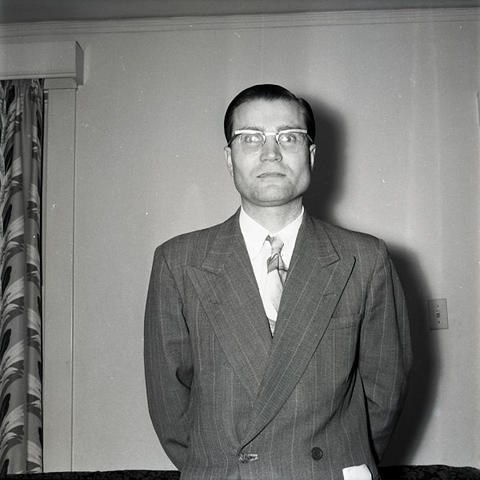
The late Dr. LaVerne Kindree had only been in Squamish a couple of years when polio came to town.
"The first case was Fern Green's husband and he had very severe bulbar polio. We had to send him out. He had to be in an iron lung for months and months," Kindree said in another Local History video about him that is also part of the Not Just For Seniors series.
"Following that, about two weeks after he became ill, we had about three or four more cases. Two weeks after that, we had about eight cases and then it just spread from there."
Because the community was isolated, the epidemiology was clearer, Kindree said, adding the path of the disease was more clear than in the city.
"One case came into the community and from that case, four more. From that case, eight more and from that case 16 — and so it spread," he said, adding it was an unusual thing for a doctor to be able to track the spread in that way.
"I figured that 95% of the population were infected with the virus, during that epidemic. Not 95% of the people got polio, but 95% of the population showed signs of viral infection without paralysis."
For about three to four months, Squamish Hospital was pretty well filled mainly with polio patients, and some maternity patients, Kindree said.
Those polio cases in the hospital did show signs of paralysis.
About six patients had to be sent out of Squamish for iron lung treatment, he said.
Kindree said that many patients could not afford the cost of the iron lung, so the government took over, though there was no public medical insurance at the time.
"Who would get paralysis and who wouldn't, there was no way of telling."
One of the things Kindree noticed was that the most important thing when people got sick was for them to rest immediately.
"People who continued to work or be active during the infective phase were more likely to get paralysis," he said.
Both he and his wife Norma got polio, but were not severely impacted.
(The Chief reached out to Norma, but she didn't want to be quoted for this story.)
"Now we have the polio vaccine and it is interesting that one of the international projects that the Rotary Club that I belong to took on... was Polio-Plus. An effort to immunize the children of the world," Kindree recalled in the 2006 video.
Role of Rotary
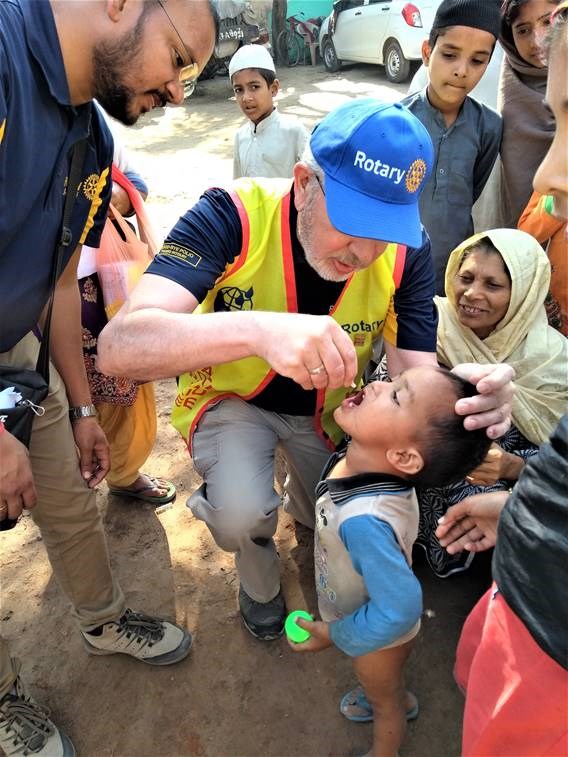
For more than 40 years, ending polio worldwide has been a goal of Rotary clubs, including for the Rotary Club of Squamish.
When the initiative started, polio was endemic in 125 countries, currently, there are only two countries where it continues to flourish, Afghanistan and Pakistan, Squamish's Brian Finley told The Chief.
"One of the reasons is misinformation on social media," he said. "The exact same thing that is happening currently with the COVID virus, where people throw out scare stories and untruths and people react to those more than the message from the health care workers."
He added that religious beliefs can prevent people from seeking the vaccine in some places.
Finley travelled to India in an area south of Delhi, in 2018 on a vaccination campaign.
Rotary had been called in to help, he noted.
"We met the local health workers and walked house to house and I was giving polio drops to the kids," he said, adding it was an amazing experience.
"All but one family was very happy to have their kids vaccinated," he said. The one mother eventually agreed to let her baby be vaccinated after the local health worker alleviated her concerns, he said.
(Support the Rotary polio effort here: https://my.rotary.org/en/take-action/end-polio.)
More local memories
Lois Sokolan says she was just a toddler, likely three years old, when her mom seemed to suddenly disappear, she would later learn it had been polio.
"I remember my nana being there all the time and my mom wasn't home," she recalled to The Chief. "And then my dad would take the kids in his truck around the old hospital — there was a road that went right around it — taking us, my brother would have been about one.... and my mom waving from the hospital room. I even remember where the room was. We were just in the truck and she waved to us."
For the rest of her life she had weakness in her legs, Sokolan recalled. Her uncle also came down with it, she recalled.
Other locals remember white sheets on windows to signal that a member of the house was sick.
"There was a lot of people around here who really got messed up by it," Sokolan recalled.
She also remembers getting the vaccine, which was put into a sugar cube.
"We thought it was great," she said, with a laugh.
Of course polio didn't just impact those in Squamish, it was global.
Brackendale's Dorte Froslev recalls being a girl in Denmark and her mom giving her and her siblings a polio test if they got sick.
"If we got sick, my mom would sit us up in bed with our legs straight in front of us and push our heads down to our knees. If we didn't squawk, we didn't have polio," she recalled. "We never did, so I don't know what the consequences would be."
What can we learn
Like with COVID, polio was at its peak right before the vaccine was able to reach all the population.
One reason for that is the size of the cohort of young children — who were most impacted by the disease — grew sharply after the Second World War in the U.S and Canada. Urbanization and other factors also played into the peak of polio in about 1952.
"Polio had been around for a long time, sort of coming and going over the years, but it was actually never worse shortly before the first vaccine became available," said Mitchell Hammond, assistant professor in the History Department at UVIC.
Hammond notes that while in the 50s newspapers published the names of polio sufferers and families put up sheets on their doors to announce they were quarantined, today we have dashboards of numbers that show the impact of COVID-19 around the world.
While parallels can be drawn between polio and COVID-19 — social fear, quarantines, a wait for a vaccine — there are significant differences.
The wait for the vaccine was much longer for the polio vaccine. The development of a COVID-19 vaccine has been unprecedentedly fast.
"Certainly, much much faster than the research program for polio which really got going in the late 1940s, but they had been at it for 35 or 40 years," Hammond said.
And society had a different attitude toward government and science than today.
People invested much more faith in public officials at that time, Hammond notes.
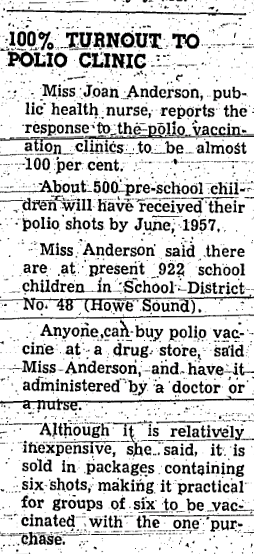
In a 1957 The Howe Sound Squamish Times article, it says: "Miss Joan Anderson, public health nurse, reports the response to the polio vaccination clinics to be almost 100%.”
That is hard to imagine today, with vaccine hesitancy more prevalent.
"There were procedures for testing vaccines, but not nearly to the level that there are today. The degree of scrutiny that these vaccines go through now is much higher," Hammond said, adding that for the most part, Canadians put their faith in then-minister of health Paul Martin Sr. and his assertion that the vaccine was safe for their kids and themselves.
Today, there is much more transparency, with vaccine protocols even published online and dashboards with COVID-19 cases, but people have less faith in what they are told.
"Another difference is that concerns in vaccines can be amplified by the internet," he said. "They can also be taken out of context. Something that happens basically anywhere in the world, even if it is conjecture, these things can be put into the media environment... And allegations that have been debunked, can continue to live on."
Hammond said putting faith in scientific institutions and in scientific processes that only a few people understand, is scarier for people than it was in Martin Sr.'s day, “where people were more accepting of authorities of almost any kind, but especially of science."
“In the 1950s, on balance, people were convinced science was going to make lives better and harms were not going to come from the efforts of scientists.”
Further, our society has become more individualistic than it was when polio came to town.
COVID has been quite mild for many people, Hammond notes.
"It becomes very difficult, especially in our world where we have been nudged to behave more as individuals and as… people thinking and acting for ourselves, and for our own benefit," he said. "It is not as straightforward for people today to discern the collective benefit because they don't see it affecting everybody in a bad way, they don't have the personal experience and they are encouraged to do what is right to look out for Number 1 — that is signalled ever more stronger in our society — so all of those things work together to make people play the odds for COVID being not so serious for them and their loved ones."
Another thing Hammond asks himself is if COVID-19 impacted children more than elders — the way polio was a 'guided missile against children" — would the response to vaccines be the same?
"My sense is if children were dying by the thousands or the many hundreds of thousands, people would be standing in line yesterday to get the COVID vaccine and encouraging their children to do the same. Because it is elders in long-term care, who are already segregated and sort of removed from the comings and goings of more active people, I think it is easier to disregard the collective benefit."
Hammond says the success of COVID-19 vaccinations will come down to management and trust in governance.
He quotes Dr. Halfdan Mahler, former World Health Organization director-general, who described the smallpox eradication program as "a triumph of management, not of medicine."
"I think that today we are absolutely seeing how true that is, that our success with COVID-19 vaccines is going to be a triumph of management," Hammond said.
"As they are discovering in the United States, it is possible to have a substantial supply of vaccine that doesn't get used, at least right away, if you don't have the organizational capacity to store it properly, to give it to the cases where it is needed and get it into people's arms."
Another interesting difference between the polio era and the current pandemic is that the polio vaccine trials in the U.S. were essentially run by a private foundation — the National Foundation for Infantile Paralysis, which is today known as the March of Dimes.
"They were actively involved in the funding and the orchestration of this. We are asking our government to do that, which I think is the way it should be. It is just remarkable we are being asked to put faith in our governments at different levels in ways that I think are hard for some people to do. I think it is reminding us just how important it is for all of us to work together...It is a test for all of us working together in our society to go to work on a very complicated problem that doesn't affect every person equally, and that is part of the challenge with COVID. "
"It is a real gut check whether or not you want to foster a world where everybody has a measure of protection and social safety, so it is a challenge in that way."
